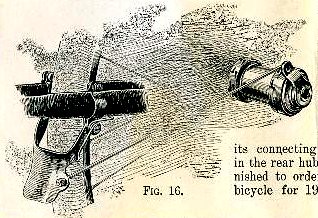 .
.The full page of the 1900 Columbia Bicycle catalog is here.
COASTER BRAKE — This device enables the rider to stop pedaling on down grades, or at any time when a sufficient degree of speed has been attained, the wheel continuing to coast along while the feet are held stationary on the pedals at any convenient position. We have experimented for many months with coaster brakes of various types and designs, and now have the pleasure of announcing that we shall be able to supply a coaster brake which has stood the most exacting tests of hard usage on rough roads and which we know to combine effective operation with great durability. The clutch in the rear hub is simple, positive in action and designed to avoid all wedging of the parts and all hurtful shocks in their engagement. The brake is of the outside type, acting upon the rear tire.So, unlike a modern coaster brake, the braking action comes from an external "spoon" that is actuated by a rod that runs from the rear hub to the front of the rear tire. The major advantage here is that the bike coasts when you stop pedaling, such as descending a hill. Previously bikes had "direct drive" and when you stopped pedaling, you didn't coast, you stopped! (Like a modern fixed-gear bike.) But if a typical fixed-gear bike set-up is converted to being able to coast, there is no ability to stop! So a brake was suddenly essential.
A slight backward motion of the pedal from any position throws back the oscillator seen in the cut and draws the brake spoon against the tire with a force easily graduated and controlled according to the needs of the situation. Upon relieving the backward pressure, the wheel coasts on with entire freedom, or the forward pedaling may be resumed. All of the apparatus except the brake spoon and its connecting rod is contained in the rear hub. It will be furnished to order on any Columbia bicycle for 1900. Price, $5.00.
A similar "spoon" type brake was also an additional option for the front tire, actuated by a hand lever.
No comments:
Post a Comment